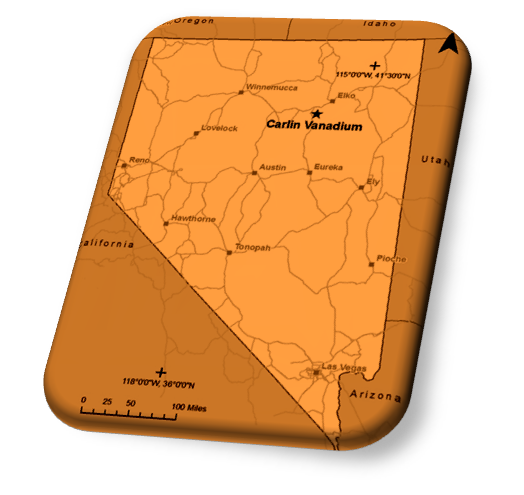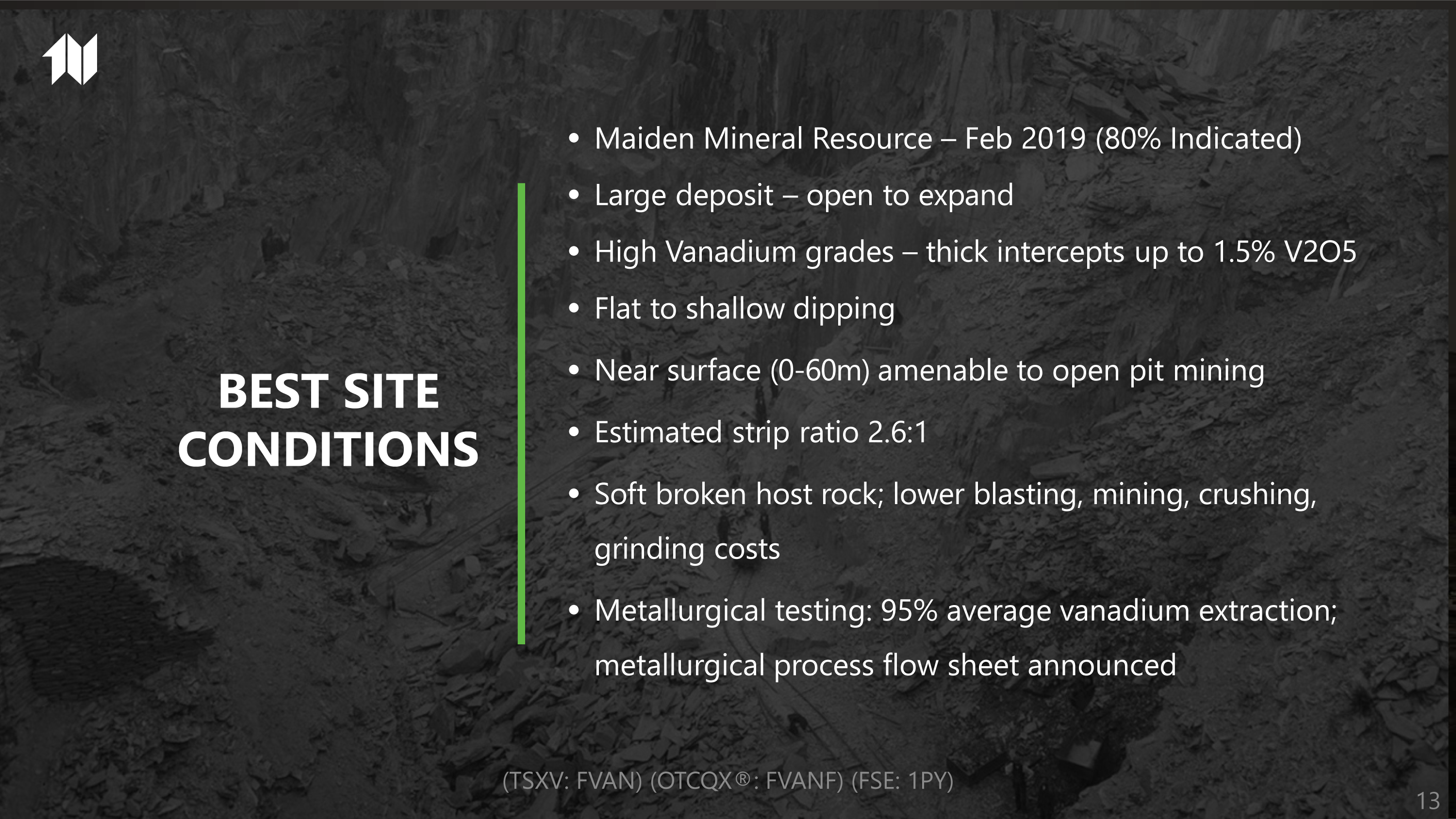Carlin Vanadium
Recent Site Photos


Carlin Vanadium Property Description and Ownership
The Carlin Vanadium Property consists of 150 unpatented mining claims and 80 acres of fee simple land covering 2,608 acres located in North-Central Nevada in Elko County, seven miles south of Carlin. The property has exceptional infrastructural advantages. The property is road accessible from Carlin and Elko. Carlin is a major rail hub to both coasts. Power is <3 miles from the property. The property was explored and drilled by Union Carbide Corporation (UCC) in the late 1960’s resulting in a defined vanadium resource.
The core 72 claims are owned by Golden Predator US Holding Corp. (GPUS). America’s Gold Exploration Inc. (AGEI), holds an option to acquire 100% of the Carlin Vanadium Project from GPUS which was assigned to First Vanadium through a definitive Assignment Agreement with AGEI. The terms for First Vanadium to earn 100% are present in its News Release of November 9, 2017. An additional 78 adjacent claims were staked and owned 100% by First Vanadium.

Geology and Mineralization
The Carlin Vanadium Property is located on the western flank of the Piñon Range, a block faulted horst of the Basin and Range tectonic province. The local lithologies are predominantly Paleozoic age (Permian to Mississippian), western assemblage, siliceous sedimentary rocks, shale, siltstone, chert, limestone and conglomerate, transported above the Roberts Mountain Thrust. The vanadium mineralization is stratigraphically controlled and appears to follow the strike and dip of the host lithology, near the contact between an overlying grey-brown siltstone and an underlying brown to black shale unit of the Devonian-age Woodruff Formation. The mineralized zones form stratigraphic subunits or beds of the Woodruff Formation shale hosting elevated concentrations of vanadium in the form of vanadium pentoxide (V2O5).
Drilling to date has defined multiple zones of vanadium enriched mineralization (>0.2% V2O5) both in the overlying grey-brown siltstone and brown-black shale unit. The most persistence, thick and highest-grade vanadium unit lies in the brown-black shale unit and averages approximately 115 ft (35 meters (m)) thick, striking north-south over 6,000 ft (1,800 m) in length and 2,000 ft (600 m) wide in the east-west direction. Although most of the deposit is flat to very shallow dipping, it appears to be gently folded anticlinally, with dips locally east and west up to 30o. The mineralization is locally exposed at surface but mostly at a shallow depth to 200 ft (60 m) from surface. Parts of the sequence and deposit are oxidized and exhibit red-purple color in higher vanadium grades.
Gold Target on Carlin Vanadium Property
In an effort to evaluate and interpret the potential significance for the Company’s Carlin Vanadium Project to host significant gold mineralization at a project that is strategically located within the prolific Carlin Gold Trend of Nevada, the Company engaged renowned Carlin Gold Trend specialist and former Newmont Mining Corporation Regional Exploration Manager, Dave Mathewson to evaluate the largely underexplored gold targets identified at depth within the project.
Dave Mathewson has interpreted a Carlin-style high-grade gold target at depth on the Carlin Vanadium Project (see figure below). Mr. Mathewson interprets a 9-mile long north-south structure that sub parallels the Bullion Fault that is associated with gold deposits on the nearby Gold Standard Ventures property. The 9-mile long north-south structure has associated hydrothermal alteration at surface and at depth (from limited historic drilling) and localized gold mineralization. Four miles north of the Company’s property and along that structure, drilling by Evolving Gold Corp. encountered high-grade gold mineralization at depth in the Arch Zone, including 19.5m at 11.76g/t Au. The limited historic drilling along the structure also suggests that favourable lithologies (Popovich Formation) may dip closer to surface southward. A 5.5-mile-long linear gravity anomaly occurs along the north-south structure. Gravity anomalies in the Rain District are coincident with large hydrothermal alteration systems at depth.
The Company’s Carlin Vanadium Project covers 2 miles of the 9-mile long structure and 2 miles of the linear gravity high. Mr. Mathewson interprets surface outcrops of silicification and elevated gold and trace element values on the property as expressions of hydrothermal fluid leakage from a high-grade gold target at depth where these key NW, NS and NE oriented structures are projected to intercept favourable lithologies known to host gold deposits elsewhere on the Carlin Gold Trend. The gold-bearing outcrops on the property (Black Kettle Au outcrops) were previously drill tested to shallow depths by Santa Fe Gold and Cambior in the 1980’s and 1990’s with some success, however, the depth potential was not recognized then.
Exploration
UCC explored the property from 1966-1970 with surface mapping, 17.8 line miles of road building, 3.3 line miles of caterpillar trenching and one hundred twenty-seven (127) rotary drillholes totaling 31,095 ft (9,478 m). In 2010, SRK generated a 43-101 compliant Inferred resource from the historic UCC data.
First Vanadium acquired the property in late 2017 and completed mapping and core and reverse circulation drilling in 2017-2018. The First Vanadium drilling of 89 holes totaling 20,521 ft (6,255 m):
- Confirmed and improved the confidence of the geological model of the deposit
- Confirmed and improved continuity of grade and thickness of the high-grade near surface vanadium unit
- Provided samples from across the full span of the deposit for metallurgical test work
Results from the both UCC and First Vanadium drilling totaling 216 holes were applied to the current Mineral Resource Estimate.

Vanadium Mineral Resource Estimate
SRK Consulting (U.S.), Inc. (“SRK”) completed an independent National Instrument 43-101 (“NI 43-101”) compliant mineral resource estimate (Table 1) on the Carlin Vanadium deposit, reported in the Technical Report titled “NI 43-101 Technical Report, Carlin Vanadium Project, Carlin, Nevada” dated April 9, 2019. A 0.3% V2O5 Cut-off grade was chosen for resource reporting based on the reasonable potential for economic extraction under a conceptual open pit mining and milling scenario.
Table 1. Carlin Vanadium Mineral Resource Statement at 0.3% V2O5 Cut-off grade (CoG) (Effective Jan. 31, 2019)
| Classification | CoG (% V2O5) | Grade (% V2O5 ) | Tons (in millions) | V2O5 lb (in millions) |
| Indicated | 0.3 | 0.615 | 24.64 | 303 |
| Inferred | 0.3 | 0.520 | 7.19 | 75 |
- Mineral Resources are not Mineral Reserves. Mineral resources which are not mineral reserves do not have demonstrated economic viability. There has been insufficient exploration to define the Inferred Resources tabulated above as an Indicated or Measured Mineral Resource. There is no guarantee that any part of the mineral resources discussed herein will be converted into a mineral reserve in the future.
- The Mineral Resources in this estimate were calculated using the Canadian Institute of Mining, Metallurgy and Petroleum (CIM), CIM Standards on Mineral Resources and Reserves, Definitions and Guidelines prepared by the CIM Standing Committee on Reserve Definitions and adopted by CIM Council.
- The mineral resources listed in Table 1 are confined within a Whittle Pit Shell with a 45⁰ pit slope and a strip ratio of 2.6:1 waste to ore including all categories. The following parameters were used to construct the Whittle pit shell and to derive the mineral resource cut-off grade of 0.3% V2O5: Metal prices: US$12.50/lb V2O5 flake, Mining: US$2.50/t, Processing: US$52.50/t, G&A: US$1.50/t, Product Transport: $2.00/t, Process Recovery: 85%.
- Contained pounds may not add due to rounding.
SRK stated that the mineral resource estimate contained on the current land package is of sufficient size and quality to continue development to prefeasibility level. Acquisition of adjacent property may have upside potential for exploration of V2O5 mineralization.
In the Technical Report a Sensitivity analysis of the Carlin Vanadium Project’s NI 43-101 mineral resource estimate was also provided for V2O5 at various cutoff grades:
| Classification | CoG (% V2O5) | Grade (% V2O5) | Tons (in millions) | V2O5 lb (in millions) |
| Indicated*1 | 0.2 | 0.539 | 31.26 | 337 |
| 0.3*2 | 0.615 | 24.64 | 303 | |
| 0.4 | 0.702 | 18.64 | 262 | |
| 0.5 | 0.776 | 14.44 | 224 | |
| 0.6 | 0.849 | 10.92 | 185 | |
| 0.7 | 0.929 | 7.80 | 145 | |
| 0.8 | 1.012 | 5.32 | 108 | |
| Inferred*1 | 0.2 | 0.450 | 9.72 | 87 |
| 0.3*2 | 0.520 | 7.19 | 75 | |
| 0.4 | 0.596 | 4.94 | 59 | |
| 0.5 | 0.677 | 3.18 | 43 | |
| 0.6 | 0.745 | 2.08 | 31 | |
| 0.7 | 0.847 | 1.05 | 18 | |
| 0.8 | 0.959 | 0.53 | 10 |
*1 Mineral Resources are not Mineral Reserves. Mineral resources which are not mineral reserves do not have demonstrated economic viability. There has been insufficient exploration to define the Inferred Resources tabulated above as an Indicated or Measured Mineral Resource. There is no guarantee that any part of the mineral resources discussed herein will be converted into a mineral reserve in the future.
*2 The Base Case reported resources are highlighted in bold and have been constrained within a US$12.50/lb V2O5 optimized pit shell described above.
Vanadium Metallurgical Test Work
The Company commenced acid leach and pressure oxidation test procedures from the deposit in April 2018. By June 2018, test work indicated 95.5% vanadium extraction into solution. Subsequently, the extraction process had been further refined with the Company progressing to the stage of variability test work, reporting in April 2019 consistently high vanadium extraction rates, between 92% and 98%, for both oxidized and unoxidized mineralized material of low, average and high vanadium grades.
Ongoing metallurgical test work on the two ore types – oxidized and un-oxidized – led to the development in early August 2019 of a preliminary process flowsheet. The flowsheet is designed to extract and recover vanadium as high-quality vanadium pentoxide using conventional technology. The process flow sheet follows four generalized steps:
- Crushing and grinding;
- Pre-concentration to reduce the volume of feed to the pressure oxidation circuit;
- Acid leach and pressure oxidation to extract the vanadium into solution; and,
- Solvent extraction to generate a commercially pure vanadium pentoxide (V2O5) flake product.
Technical disclosure has been reviewed and approved by Paul Cowley, PGeo., a Qualified Person as defined by National Instrument 43-101, and President and CEO of the Company.




